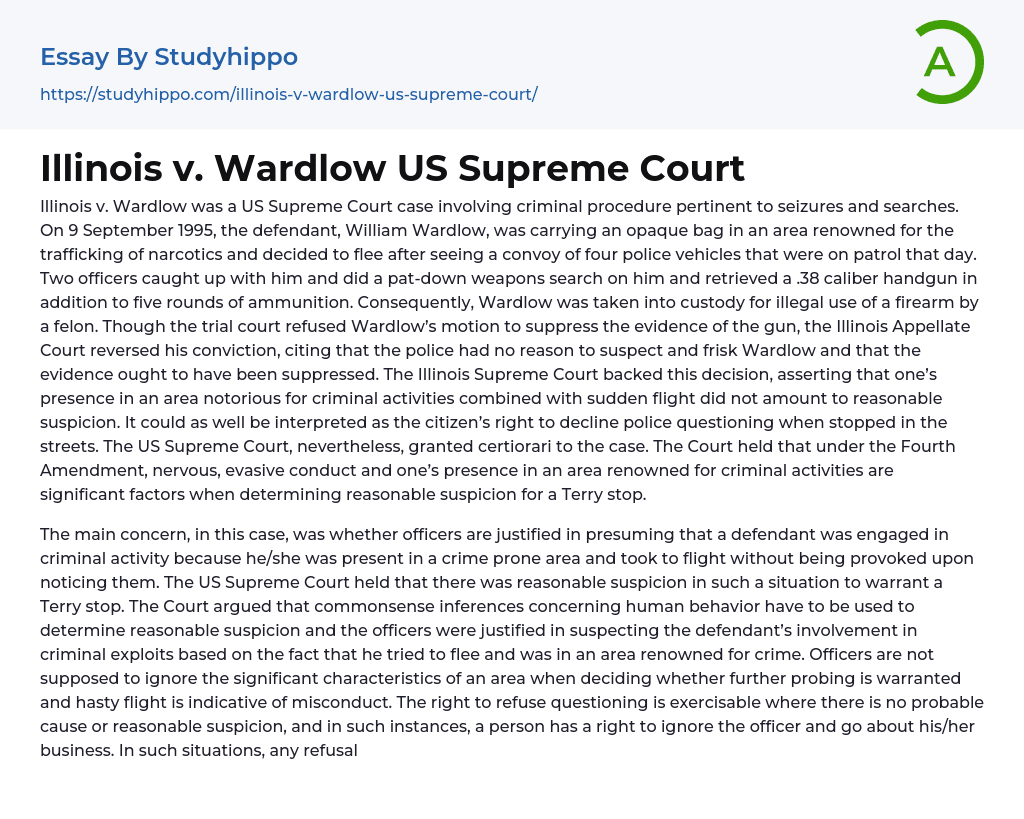Illinois v. Wardlow was a US Supreme Court case involving criminal procedure pertinent to seizures and searches. On 9 September 1995, the defendant, William Wardlow, was carrying an opaque bag in an area renowned for the trafficking of narcotics and decided to flee after seeing a convoy of four police vehicles that were on patrol that day. Two officers caught up with him and did a pat-down weapons search on him and retrieved a .38 caliber handgun in addition to five rounds of ammunition. Consequently, Wardlow was taken into custody for illegal use of a firearm by a felon. Though the trial court refused Wardlow’s motion to suppress the evidence of the gun, the Illinois Appellate Court reversed his conviction, citing that the police had no reason to suspect and frisk Wardlow and that the evidence ought to have been suppressed. The Illinois Su
...preme Court backed this decision, asserting that one’s presence in an area notorious for criminal activities combined with sudden flight did not amount to reasonable suspicion. It could as well be interpreted as the citizen’s right to decline police questioning when stopped in the streets. The US Supreme Court, nevertheless, granted certiorari to the case. The Court held that under the Fourth Amendment, nervous, evasive conduct and one’s presence in an area renowned for criminal activities are significant factors when determining reasonable suspicion for a Terry stop.
The main concern, in this case, was whether officers are justified in presuming that a defendant was engaged in criminal activity because he/she was present in a crime prone area and took to flight without being provoked upon noticing them. The US Supreme Court held tha
there was reasonable suspicion in such a situation to warrant a Terry stop. The Court argued that commonsense inferences concerning human behavior have to be used to determine reasonable suspicion and the officers were justified in suspecting the defendant’s involvement in criminal exploits based on the fact that he tried to flee and was in an area renowned for crime. Officers are not supposed to ignore the significant characteristics of an area when deciding whether further probing is warranted and hasty flight is indicative of misconduct. The right to refuse questioning is exercisable where there is no probable cause or reasonable suspicion, and in such instances, a person has a right to ignore the officer and go about his/her business. In such situations, any refusal to comply does not suffice the minimal level of impartial justification necessary for seizure or detention. In this case, however, Officer Nolan had sufficient reason to suspect that Wardlow was engaged in criminal activity and so to probe further.
Justice John Paul agreed in part to the Court’s rejection of a proposed rule by the state courts to sanction the detention of anyone who attempts to flee at the sight of a police vehicle, but also dissented in part when he rejected the idea that such flight could never warrant a Terry stop. Accordingly, he argued that unprovoked flight even in high crime zones does not automatically amount to reasonable suspicion to give grounds for a Terry stop and frisking. This case, in essence, shifts the balance towards police freedom in contrast with the rights of individuals. Nonetheless, the question as to how far this case limits the ability of citizens
to shun the police and yet not be stopped remains. Will walking into a corner store when the police show up provide sufficient grounds for a Terry stop? Though it may seem unlikely, the outcome of this case creates such issues.
- Animal Cruelty essays
- Charles Manson essays
- Crime Prevention essays
- Crime scene essays
- Criminal Justice essays
- Criminology essays
- Cyber Crime essays
- Damages essays
- Detention essays
- Distracted Driving essays
- Drug Trafficking essays
- Drunk Driving essays
- Forensic Science essays
- Gang essays
- Hate Crime essays
- Homicide essays
- Identity Theft essays
- Juvenile Crime essays
- Juvenile Delinquency essays
- Juvenile Justice System essays
- Law Enforcement essays
- Murder essays
- Organized Crime essays
- Penology essays
- Piracy essays
- Prison essays
- Property Crime essays
- Prostitution essays
- Punishment essays
- Punishments essays
- Rape essays
- Robbery essays
- Serial Killer essays
- Sexual Assault essays
- Sexual Assault on College Campuses essays
- Sexual Harassment essays
- Sexual Offence essays
- Stealing essays
- Surveillance essays
- Ted Bundy essays
- Victim essays
- Violent crime essays
- White Collar Crime essays
- Supreme Court essays
- Supreme Court Of The United States essays




